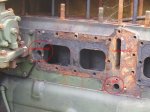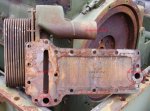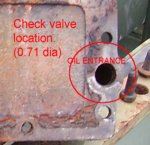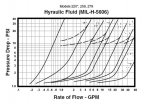Prelubing via the filter housing port(s) may not be possible, if the oil drains back to the pan when the oil pump stops, why wouldn't it be pushed back that way with the external pump also?
The "oil entrance" marked in one image above is the ideal location for a check valve and may be the answer to the very first post in this thread. If a check valve could be installed here, the filters and oil cooler wouldn't drain and we would have a much faster "to pressure" condition.
I'm not sure that the idea of a bypass filter has been explained, since it's such a great solution. With a bypass filter in the system, filtering the oil at a much slower rate and down to 5 or 10 microns, the entire oil supply will keep getting dilluted with cleaner and cleaner oil. After so many cycles all the oil will have gone thru the by pass filter. It is not done as fast as a full flow filter, it may take 10 or 20 cycles to clean the oil. When you are on the road and running the engine at rpm, that may only be minutes anyway, so no problem, all the oil will eventually be cleaned to the level of the by pass filter. One can express the procedure mathematically if needed, just think of the new oil entering the bypass filter as having 5% less soot than previous batch etc etc.
It's possible that oils from the period, when the engine was designed, (I'm checking this one) did not suspend soot particles and they simply settled out in the pan, meaning that they didn't need to be filtered out.
Newer oils demand a finer filter, thus the need for a bypass filter....still checking.
The deuce filters operate with relatively low pressure (bypass at only 15 psi) and may be very efficient that way. New full flow filters, mentioned above has a bypass pressure of twice that, perhaps they get clogged quicker....








